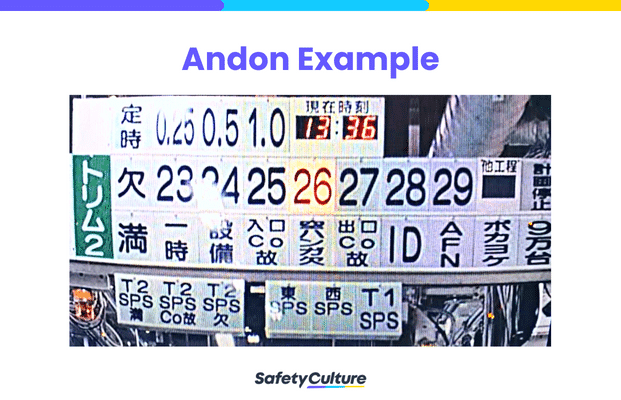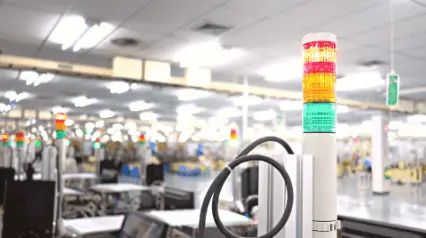What is Andon?
Andon is a visual management system used by operators and managers in lean manufacturing to easily determine and display the status of production lines. It originates from a Japanese term meaning “paper lantern” with a more accurate English translation as “sign” or “signal” based on the Jidoka methodology of the Toyota Production System (TPS). The system works by pulling the Andon cord to signal problems encountered or assistance requested, changing the color of the Andon light, and reflecting the update on the Andon board. It aims to alert about issues in real-time so solutions can be implemented immediately, decreasing downtime and saving costs.
Andon System: How Does It Work?
Previously, production personnel left their posts to look for solutions, but with Andon, the solution is brought directly to the working area. It is a system that has been tried and tested to streamline workflows. Generally, Andon works through an interconnected network of three primary components: cord, light, and board. Listed below are what they mean and how they function:
1. Andon Cord
The Andon cord, cable, or rope is usually located at the overhead of assembly line workers. When pulled, it means that a production operator requires support because a problem has been identified. In some settings, the cord manifests as a button or switch. Whatever the case, its purpose remains the same in alarming others of an issue that has been spotted.
2. Andon Light
The act of pulling the cord or pressing the button also triggers the Andon light of that specific equipment or production line. The change in color helps responders quickly determine the area that needs their assistance. While other types may have additional colors such as blue and white, a simple light system displays three main colors: green, yellow or amber, and red.
- Green means production is normal or running smoothly, so continue with work as usual.
- Yellow or Amber means a problem has been identified, so respond to the signal and help the operator fix the problem or perform product quality checks.
- Red means production has been stopped, so investigate with the team leader or refer the problem to managers and fix it before continuing production.
3. Andon Board
Each with their appropriate color codes, the status of production lines automatically gets updated on the Andon board. It is a single source of truth for current manufacturing conditions. At a glance, supervisors and factory workers can view production targets, actual numbers, and total downtime, if any, fostering a culture of transparency and accountability.
Andon Example: Toyota
Seeing Andon in action can help demonstrate exactly how the system works. When it comes to putting the principle into practice Toyota is well-known for taking the lead. Here is a real-life example of Andon in the workplace:
In Toyota, Andon functions as an alert system that can lead to a line stop. By using the cord which typically comes with an alarm sound, the Andon board lights up and team leaders get notified about an issue in a specific production line. If it cannot be resolved within a certain amount of time, then the line stops. Every Toyota employee can stop the manufacturing line if they perceive something as a threat to vehicle quality.

Example of Andon in Toyota | Image Source
Benefits of Andon in Lean Manufacturing
As a visual control system applied in lean manufacturing, Andon can increase production levels by taking the time to look into problems and making the effort to fix them before they escalate. By sustaining its principles in daily operations, manufacturers can gain these significant benefits:
- Empower frontline workers through an environment of openness and trust.
- Accelerate teamwork by democratizing the ability to make decisions in production.
- Maximize raw materials and reduce the manufacture of defective items.
- Standardize product quality before it moves further down the line.
- Improve customer satisfaction and enhance value to end users.
Create Your Own Lean Manufacturing Checklist
Eliminate manual tasks and streamline your operations.
Get started for FREEHow SafetyCultureCan Support Your Andon System
Taking inspiration from traditional paper lanterns, Andon has evolved into an innovation not only for industrial use but also for commercial use. Today’s technology has played a vital role in making it easier for businesses to strengthen and scale the system. SafetyCulture (formerly iAuditor) is an operations management platform that can help teams respond to issues faster and work better together. Here’s how SafetyCulture can support Andon implementation:
Issues Reporting, Management, and Documentation
Boost employee reporting through the SafetyCulture Issues feature. With the mobile app, capture key information as soon as problems arise, so your team can handle them before they spiral out of control. Using the web app, manage issues with ease as you can view their status and updates from a user-friendly dashboard. Managers can ensure that all issues identified through Andon are properly documented and accounted for.
Assigning, Monitoring, and Record-keeping of Corrective Actions
Promote a culture of collaboration through the SafetyCulture Actions feature. Displayed in a timeline that looks like a conversation, teams can chat and attach photos to assigned actions with priority levels and due dates. Opening SafetyCulture on your desktop or laptop enables you to access all corrective actions in easy-to-understand charts to help track areas of improvement and keep compliance records. You can add up to 10 team members using your free SafetyCulture account.
Training for Proper Implementation
Creating a strong safety culture and streamlined operating system is more than just establishing a clear set of work instructions. It’s about making sure that your workforce understands those guidelines, so they can get the job done right without putting themselves or their colleagues at risk. SafetyCulture Training can help you do just that.
A good and effective Andon training lesson can help communicate to your workers the importance of following their work instructions. It can take them through the step-by-step process of how to carry out their tasks safely and effectively, bringing everyone on the same page when it comes to workplace safety.
Frequently Asked Questions
Understanding the basic elements of Andon allows companies to take practical steps toward applying a lean approach in manufacturing. Some essential details involve its history and development, purpose, and implementation. Here are our answers to 5 of the most commonly asked questions about Andon:
Phonetically, Andon is pronounced as “AHN-dohn” with a stress on the capitalized syllable. Its pronunciation (′än-dôn) is divided into two syllables using the stressed ah sound in “father” and the short oh sound in “more”.
Andon is a term that refers to a lean manufacturing system; it is neither an acronym nor an abbreviation. Technically, the origin of the Japanese word translated as “Andon” comes from using traditional lighting equipment with a fire-burning lamp made of paper and bamboo.
Toyota is widely recognized as the pioneer for adopting the concept of Andon in manufacturing. The method is often cited as an application of Jidoka, the TPS principle which aims to prevent defective products from being produced through the safe and immediate stop of equipment when abnormality occurs.
Andon is used to enable manufacturing staff to raise safety or quality concerns and resolve them before resuming production. It empowers operators to deal with issues and make decisions with a faster response time, increasing efficiency.
To implement the system, production managers should clearly establish what constitutes a problem and design mechanisms to detect and surface it. Next, plan how to strategically position the Andon board, lights, and cords so that they can be accessible and easily visible across the factory floor. Finally, assign persons responsible for responding to the signal and inform employees how long they should wait and what types of responses they can expect.




